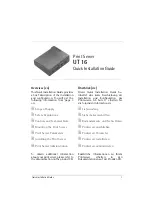
Transmission Using IPsec
This can be specified by the network administrator.
For communication security, this printer supports IPsec. IPsec transmits secure data packets at the IP protocol
level using the shared key encryption method, where both the sender and receiver retain the same key.
This printer has two methods that you can use to specify the shared encryption key for both parties:
encryption key auto exchange and encryption key manual settings. Using the auto exchange setting, you
can renew the shared key exchange settings within a specified validity period, and achieve higher
transmission security.
• When “Inactive” is specified for “Exclude HTTPS Communication”, access to Web Image Monitor
can be lost if the key settings are improperly configured. In order to prevent this, you can specify IPsec
to exclude HTTPS communication by selecting “Active”. When you want to include HTTPS
transmission, we recommend that you select “Inactive” for “Exclude HTTPS Communication” after
confirming that IPsec is properly configured. When “Active” is selected for “Exclude HTTPS
Communication”, even though HTTPS transmission is not targeted by IPsec, Web Image Monitor might
become unusable when TCP is targeted by IPsec from the computer side. If you cannot access Web
Image Monitor due to IPsec configuration problems, disable IPsec on the control panel, and then
access Web Image Monitor. For details about disabling IPsec using the control panel, see p.126 "
Deactivating IPsec Using the Control Panel".
• IPsec is not applied to data obtained through DHCP, DNS, or WINS.
• IPsec compatible operating systems are Windows XP SP2, Windows Vista/7, Windows Server
2003/2003 R2,2008/2008 R2, Mac OS X 10.4 and later, Red Hat Enterprise Linux WS 4.0, and
Solaris 10. However, some setting items are not supported depending on the operating system. Make
sure the IPsec settings you specify are consistent with the operating system's IPsec settings.
Encryption and Authentication by IPsec
IPsec consists of two main functions: the encryption function, which ensures the confidentiality of data, and
the authentication function, which verifies the sender of the data and the data's integrity. This printer's IPsec
function supports two security protocols: the ESP protocol, which enables both of the IPsec functions at the
same time, and the AH protocol, which enables only the authentication function.
ESP Protocol
The ESP protocol provides secure transmission through both encryption and authentication. This
protocol does not provide header authentication.
• For successful encryption, both the sender and receiver must specify the same encryption
algorithm and encryption key. If you use the encryption key auto exchange method, the
encryption algorithm and encryption key are specified automatically.
7. Enhanced Network Security
102
7
Summary of Contents for Aficio SP 5200DN
Page 17: ...17 MEMO...
Page 18: ...18 MEMO...
Page 19: ...19 MEMO...
Page 20: ...20 MEMO 2010 Printed in France EN GB M020 8510...
Page 30: ...Model types Model types Model name Type 1 SP 5200DN Type 2 SP 5210DN 8...
Page 34: ...Manuals provided are specific to printer types 12...
Page 38: ...16...
Page 52: ...1 Guide to the Printer 30 1...
Page 64: ...If the hard disk is active If the printer s cover is opened 2 Setting Up the Printer 42 2...
Page 122: ...5 Configuration 100 5...
Page 184: ...7 Maintaining the Printer 162 7...
Page 192: ...8 Adjusting the Printer 170 8...
Page 212: ...9 Troubleshooting 190 9...
Page 223: ...12 Close the front cover CEC214 Paper Misfeed Message B C 201 10...
Page 226: ...CEC082 10 Removing Misfed Paper 204 10...
Page 230: ...10 Removing Misfed Paper 208 10...
Page 244: ...11 Appendix 222 11...
Page 247: ...2010...
Page 248: ...Operating Instructions Hardware Guide M020 8502 EN US...
Page 256: ...6...
Page 284: ...2 Network Connection 34 2...
Page 298: ...4 When Using the Printer under Mac OS X 48 4...
Page 310: ...MEMO 60 EN GB EN US M0208518...
Page 311: ...2010...
Page 312: ...Operating Instructions Driver Installation Guide M020 8518 GB EN US EN...
Page 321: ...Trademarks 217 INDEX 219 7...
Page 324: ...Model types Model types Model name Type 1 SP 5200DN Type 2 SP 5210DN 10...
Page 328: ...14...
Page 338: ...1 Preparing for Printing 24 1...
Page 351: ...CBK525 Down then Left CBK526 Frequently Used Print Methods 37 2...
Page 359: ...CBK504 ORIGINAL CBK505 COPY CBK501 Advanced Printing 45 2...
Page 452: ...4 Making Printer Settings Using the Control Panel 138 4...
Page 470: ...5 Monitoring and Configuring the Printer 156 5...
Page 480: ...6 Using a Printer Server 166 6...
Page 497: ...For details see Using telnet UNIX Supplement Using the Dynamic DNS Function 183 8...
Page 535: ...2010...
Page 536: ...Operating Instructions Software Guide M020 8504 EN US...
Page 545: ...For details about the specifications of each option see Specifications Hardware Guide 7...
Page 548: ...10...
Page 674: ...8 Specifying the Extended Security Functions 136 8...
Page 680: ...9 Troubleshooting 142 9...
Page 702: ...10 Appendix 164 10...
Page 705: ...MEMO 167...
Page 706: ...MEMO 168 EN GB EN US M0208505...
Page 707: ...2010...
Page 708: ...Operating Instructions Security Guide M020 8505 EN US...
Page 821: ...MEMO 111...
Page 822: ...MEMO 112 EN GB EN US M0668513...
















































